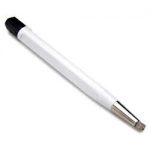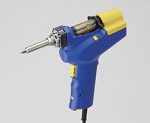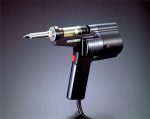This article was originally posted on PinballRehab.com.
Reproduced with permission from terryb.
Written by terryb

A. Basic Soldering Tutorial
B. Basic Desoldering Tutorial
– Supplies Needed
C. Tools for Advanced Soldering
D. Advanced Soldering Tutorial
E. Advanced Desoldering Tutorial 
When it comes to desoldering there are numerous tool choices. In some cases which one you use is a matter of personal preference while in other cases the tool you use should be based on the job. For purposes of this discussion I’ll break desoldering into two categories: under-playfield soldering (solenoids, switches, diodes and wiring) and circuit board components.
Basic desoldering tools for under-playfield work include solder wick, a desoldering bulb or a desoldering pump (called a solder sucker by us old-timers). While the latter two items use vacuum pressure to suck up solder the solder wick “soaks-up” or wicks away solder.
![]() [Editors note: We suggest a metal body solder sucker. The plastics ones seem to not last very long. We have had the same metal ‘Swiss made’ solder suckers for 20 years and they work as good as new. The one we have was distributed by Techni-Tool but no longer seems available. The Weller solder sucker looks similar.]
[Editors note: We suggest a metal body solder sucker. The plastics ones seem to not last very long. We have had the same metal ‘Swiss made’ solder suckers for 20 years and they work as good as new. The one we have was distributed by Techni-Tool but no longer seems available. The Weller solder sucker looks similar.]
Make sure the solder wick has flux and is a high quality brand, it does make a difference. A width of .015″ to .020″ is a good choice for the solder wick.
Of the three choices, I don’t think the solder bulb works as well as the others. Most beginners will probably find a solder sucker the easiest to use. I suggest the shorter type (approximately 6″ rather than 8 or 9″) since it’s easier to manage one-handed. Pick up some extra tips since you they will need replacement every so often.
 Many experienced solderers will use the solder sucker to remove the majority of solder and then use solder wick for final clean-up.
Many experienced solderers will use the solder sucker to remove the majority of solder and then use solder wick for final clean-up.
In addition you will need a fiberglass pen and flux. The fiberglass pen is available at Radio Shack and used for mechanically removing oxidation from joints before desoldering. A good quality flux (I recommend DeoxIT, Kester or MG Chemicals)is used for chemically removing oxidation and helping the solder flow during desoldering.
 For circuit board work, Radio Shack [used to sell] a 45 Watt desoldering iron with a bulb attached to it for $12. While it sounds like a good idea, the tip temperature of approximately 788 degrees is way too hot for circuit board work. I therefore do not recommend it.
For circuit board work, Radio Shack [used to sell] a 45 Watt desoldering iron with a bulb attached to it for $12. While it sounds like a good idea, the tip temperature of approximately 788 degrees is way too hot for circuit board work. I therefore do not recommend it.
A vacuum desoldering tool like the Hakko 808 is the only way to guarantee you will never lift a trace or circuit pad when doing board work.

[Editors note: Unfortunately, the Hakko 808 has been discontinued. Used ones are routinely available for sale and highly prized. The Hakko FR301 which is a bit more expensive, but highly recommended. For the below discussion, the Hakko FR301 can be substituted.]

Over the years I have used numerous vacuum desoldering tools with some costing into the thousands. The good news is there’s now a solution that in my opinion even beats out the industrial grade products–and costs a lot less. The Hakko 808 Desoldering Kit and is truly pure magic.
Pick up some extra ceramic filters while you’re at it.
The 808 looks kind of like a soldering gun and has a built-in vacuum pump, which is much more efficient than a desoldering station where the vacuum passes through a long tube before getting to the gun (losing pressure the whole way). The Hakko’s tip is round with a hole in the middle that fits over the component lead and provides the vacuum pressure when the trigger is depressed. The product comes with a 1mm tip which is fine for IC”s, resistors and such, but you should also purchase the 2.3mm tip for components with larger leads like TIP36 transistors.
There is some slight technique involved which is explained in the product manual. The main thing is to keep the tip from touching the circuit board. If you have any trouble with this slide the end of a toothpick under the tip as the solder melts. This is especially important because the Hakko runs hotter than what is normally recommended for desoldering (the reason they get away with this is because it desolders so quickly).
There are five temperature selections ranging from 715 – 895 degrees. Hakko recommends using the 1 – 2 setting for single layer boards, 3 – 4 for through-hole boards and 5 for multilayer boards. Personally I use the 2 setting most of the time.
Note: Check the setting before desoldering, it comes set pretty high from the factory.
Please note in the included video how a distance is maintained from the board. Although the rocking motion used to free the lead in the video is correct it is done for too long a period (six seconds, when only about 2 seconds is needed) and the vacuum is running constantly rather than just firing it once or twice once the solder is liquid and you’re lead is wiggling..
I truly can’t say enough about this product, and you don’t have to take my word for it, read the reviews at Amazon.
Comments
Comments, including suggestions, improvements, errors, etc. are welcome (see below).
If you have a specific question about your game that does not directly apply to desoldering tools, please see our FAQ section.
